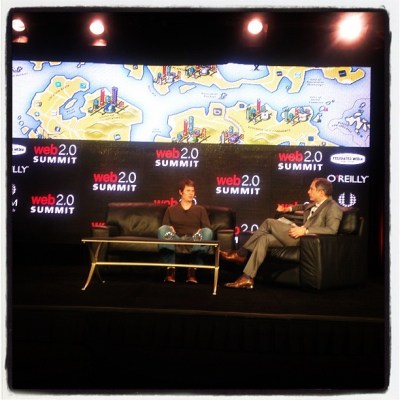This afternoon at The Web 2.0 Summit, Pandora Co-founder Tim Westergren sat down with Fortune Editor Adam Lashinsky to talk about what’s going on at everybody’s favorite personalized radio platform. For those who may have missed it, Pandora recently enjoyed a relatively high-profile IPO, putting its “P” ticker symbol right smack in the middle of “IPO” — and the NYSE. And its stock has remained pretty high, both literally and figuratively, pricing at over $16 a share on its opening day, and is today trading around $15.20 per share. So far, so good.
Furthermore, today the company counts 37 million active users and, as Westergren has said on multiple occasions, is finally hitting scale. Part of the reason that the co-founder believes that the company has been able to reach scale, and continue to grow across mobile and the web, is due to the fact that the entire industry is shifting from broadcast/terrestrial radio to personalized radio.
Of course, Westergren is wont to say that this shift is endemic to an entire industry, as Pandora has really been at the forefront of pushing personalized radio across different forms of media. And, based on its mobile adoption in particular, where Pandora reaps 70 percent of its users, it doesn’t look like Westergren is wearing rose-colored glasses.
Another interesting statistic the co-founder mentioned today was that Pandora currently has over 900,000 songs in its repertoire, and the majority of those songs were played last month — one of the biggest differences between traditional and new radio, where the diversity of the musical catalog is far smaller.
Therein lies Pandora’s value proposition: Allowing listeners to personalize their radio experience, as well as exposing listeners to a wider breadth of artists, songs — and, in turn, giving artists a far longer reach than ever before. To this point, Westergren said, “new” radio is helping the long-tail, by playing more songs.
And, it’s important to note that Pandora pays to performers. While this may hamstring the platform a bit financially, it’s great for musicians. Terrestrial (or broadcast) radio only pays publishing fees, which go to composers and record labels, but not to performers. Musicians rejoice.
But, what about Spotify, you ask? Revenue from subscribers only made up about 15 percent of Pandora’s revenue in 2011; the majority of its revenue is based on advertising. While Westergren said that the company needs to do a better job of monetizing through advertising in the long run, so far most of its users are cool with listening to the free, ad-supported version rather than subscribing to take advantage of ad-free listening.
Spotify, on the other hand, is predominantly subscription-based, but Westergren said that he thinks there’s room for both companies to survive and do what they do best. Ideally, he says, a Pandora power user “would find some songs they like on Pandora, and then go buy them on iTunes or listen to them on demand via Rdio or Spotify and use them in tandem,” he said. “It’s not 100 percent distinct, there’s obviously some overlap, but I think at a high level the place where we operate in the minds of users.”
Spotify, with its Facebook integration, has been exploding in the U.S., but for those looking for a one-button, low maintenance way to discover music based on their own distinct tastes, Pandora remains one of the best options out there. We’ll see what the future holds, but I’m willing to bet that both services will be around for at least a few years.
